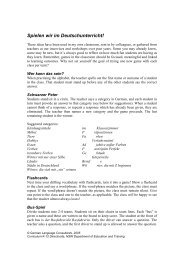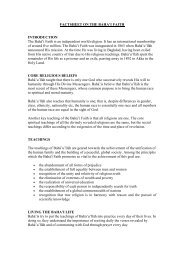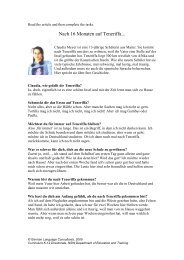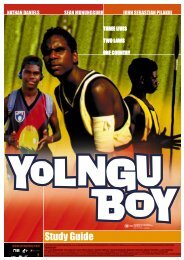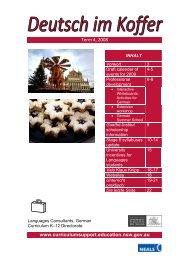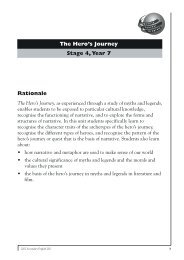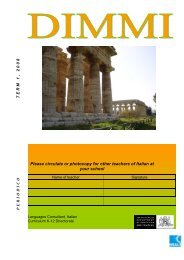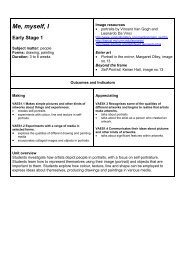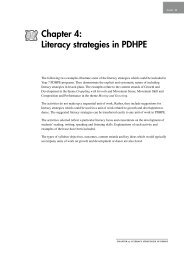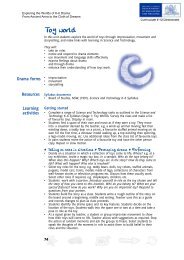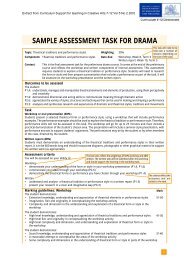Mabo Study Guide - Curriculum Support
Mabo Study Guide - Curriculum Support
Mabo Study Guide - Curriculum Support
You also want an ePaper? Increase the reach of your titles
YUMPU automatically turns print PDFs into web optimized ePapers that Google loves.
Government do this? What was the impact of this denial<br />
on Eddie <strong>Mabo</strong>?<br />
• Construct a time line of key dates which emerge in the<br />
film on changes to indigenous peoples’ rights. Include, for<br />
example, the 1967 referendum, changes which came in<br />
during the Whitlam era, etc.<br />
‘The Battle of His Life’<br />
In 1977, Eddie <strong>Mabo</strong> hired a boat and went to Mer with<br />
his family. He was appalled by the idea that his land<br />
could be considered to be Crown land and saw the fight<br />
to win the right to his land as the most important cause<br />
of his life.<br />
Eddie <strong>Mabo</strong> believed that the Land Rights movements of<br />
the ’70s and ’80s were destined to fail. He believed that<br />
the land had been stolen in the first place. This was<br />
central to his argument. He believed he could achieve<br />
justice through the courts.<br />
Eddie <strong>Mabo</strong> claimed that he was the rightful heir and<br />
owner of the land owned by his father on Murray Island. It<br />
took him 10 years to establish that certain land on Mer (in<br />
the Murray Islands) did indeed belong to him.<br />
In 1989, when the lawyers first went to Mer, the white<br />
legal view was that despite evidence of over 40,000 years<br />
of occupation, indigenous people had no concept of law<br />
and land ownership before the whites arrived. Justice<br />
Moynihan had to gather evidence on the island to test<br />
<strong>Mabo</strong>’s claim of traditional laws of inheritance.<br />
In 1990, Justice Moynihan presented his finding to the<br />
High Court of Australia that Eddie <strong>Mabo</strong> was not adopted<br />
by custom and therefore his claims on Mer were denied.<br />
In 1991, the High Court held a final hearing on the <strong>Mabo</strong><br />
case with a full sitting of the seven judges of the High<br />
Court. They decided that the real issues were that the<br />
community of Mer had a system of land ownership before<br />
white settlement. The principle of this judgement meant<br />
that native title could be established in other parts of<br />
Australia.<br />
• How did Eddie <strong>Mabo</strong> claim that land was passed on?<br />
• What did he show the judges as evidence of his claim?<br />
• Why did some island witnesses challenge Eddie <strong>Mabo</strong>’s<br />
claim?<br />
• Why did the case go on for so many years?<br />
• Why did the <strong>Mabo</strong> case cause so much personal<br />
hardship for Eddie <strong>Mabo</strong> and his family?<br />
• What impact did the 1990 Moynihan judgement have<br />
on Eddie <strong>Mabo</strong>?<br />
• Why was Eddie <strong>Mabo</strong> successful in the end?<br />
The Journey Home<br />
In June 1995, three years had passed since Eddie <strong>Mabo</strong>’s<br />
death and the mourning time was over. The time had<br />
come to celebrate his life. The simple wooden cross that<br />
had marked his grave at Townsville cemetery was<br />
replaced with a marble headstone. As a mark of respect<br />
for Eddie <strong>Mabo</strong>, many Torres Strait Islander people and<br />
others travelled to Townsville and held a special ceremony<br />
6<br />
with Torres Strait Island rituals performed by Eddie<br />
<strong>Mabo</strong>’s sisters and family at the grave. The ‘Sorry’ was<br />
finished and relatives believed that on that day,<br />
Reconciliation seemed a real possibility.<br />
• Who was a part of this celebration?<br />
• What happened at the graveside ceremony?<br />
• What happened to the grave that night?<br />
• Why do you think people would perform such an<br />
act<br />
of extreme vandalism?<br />
• Why did the family decide then that they should<br />
take Eddie <strong>Mabo</strong>’s body back to Mer?<br />
• Trevor Graham says in the film that he felt the family<br />
had to bring Eddie <strong>Mabo</strong> home for all the wrong<br />
reasons: ‘I felt ashamed that his family had to make<br />
this choice just to keep him safe.’ How did you feel<br />
when you watched these events on film?<br />
Racism<br />
• There are many stories in the film which show the<br />
racism which Eddie <strong>Mabo</strong> and his family have endured.<br />
Read what filmmaker Trevor Graham said about racism:<br />
Aboriginal people will tell you that they put up with this<br />
all the time. But we, as a nation, don’t get to<br />
experience that in the way that we did when we saw<br />
the desecrated headstone. It was big news at the time<br />
and I keep on saying to people that it is a battle of<br />
symbols. You have the symbol of Eddie <strong>Mabo</strong> and what<br />
he stood for. He really hoped that the court case would<br />
help to unite Australia. Then you’ve got the symbol of<br />
the red swastikas daubed on the tombstone. I see it as<br />
a symbolic turning point for where we are at now, which<br />
is an attack, a backlash, the rise of Pauline Hanson, the<br />
One Nation party. I see that point [of the desecration]<br />
as the beginning of that.<br />
• What is racism? In a class discussion investigate<br />
reasons for why people have racist views.<br />
• How do you react to Graham’s views?<br />
• What can young Australians do to help in the cause of<br />
Reconciliation?<br />
Religion and Traditional Values<br />
<strong>Mabo</strong> – Life of an Island Man tells us a great deal about<br />
the depth of spiritual traditions and feelings on Mer<br />
today. We see that the Elders have been able to pass on<br />
the traditional cultures through their stories and songs, in<br />
the same way that generations before them had done.<br />
• Explain the Law of Malo which is documented in the<br />
film.<br />
• What did customary law on Mer say about land rights?<br />
• What other evidence is there in the film of the<br />
continuation of deeply held religious beliefs and rituals<br />
continuing in the Torres Strait Islands?<br />
Reconciliation – Its Key Issues<br />
The Council for Aboriginal Reconciliation first met in 1992,<br />
with the aim of building bridges for a better



